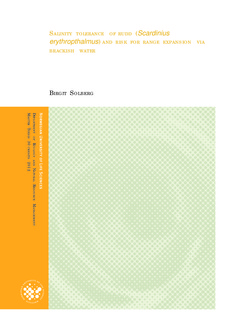Salinity tolerance of rudd (Scardinius erythropthalmus) and risk for range expansion via brackish water
Master thesis
Permanent lenke
http://hdl.handle.net/11250/186975Utgivelsesdato
2013-03-22Metadata
Vis full innførselSamlinger
- Master's theses (INA) [593]
Sammendrag
Rudd (Scardinius erythropthalmus) is a naturally occurring species in Norway which over the
last four decades has expanded its distribution far beyond its natural range. This invasion
represents a threat to local ecosystems and biodiversity. In order to find the most efficient
measures to prevent further spreading, it is crucial to find the spreading mechanism for this
species. It is assumed that anglers are responsible for introducing rudd to new water bodies,
but in this study I explore whether along-coast migration via brackish water may serve as an
additional route. Rudd from Storelva water system in southern Norway regularly performs
seawards migrations entering brackish water. In periods of high input of freshwater to the
fjord system, the brackish surface layer expands outwards, and salinities along the coast
decrease. To test whether brackish water represents a possible route for range expansion, the
salinity tolerance of rudd was tested in a laboratory experiment, and was found to be between
12 and 15 ppt. These results were applied in a risk model to determine the potential
distribution of rudd in relation to observed and simulated salinities in the Storelva-
Sandnesfjorden system. According to this model, there is high chance (given salinity
tolerance at 24 hrs) that rudd may spread all the way through the Storelva-Sandnesfjorden
system at medium (8 m3/sec) to high (100 m3/sec) Storelva discharges. Similar assessments
can be made for other water systems to predict the risk of range expansion along the Skagerak
coast of Norway.
